Topics
Category
Era
Mi Perú-Minnesota
Mi Perú-Minnesota members model a diverse range of traditional Peruvian dance attires while holding a banner with the group's logo. The banner was made in Huancayo, Peru, and intended to be used for the Modern Huaylarsh group dance. Photo by Sarah Leon Waddell, 2022. Used with the permission of Sarah Leon Waddell Photography.
Mi Perú-Minnesota (Mi Perú-MN) is a non-profit organization that promotes Peruvian culture through folkloric dances and ethnic events. Founded in Minneapolis in 2017, the group strives to bridge Peruvian and Minnesotan cultures while contributing to the diversity within Minnesota’s Latine population and society at large. Over the years, it has grown to become a multigenerational and multiethnic group with a presence as one of the primary Peruvian folkloric dance groups in Minnesota.
In the late 2000s, a group of Peruvian women living in the Twin Cities formed a Peruvian folkloric dance group called Asi Es Mi Perú (That’s My Peru). Over time, the group dissolved, leaving some of its original members, along with other dancers, to establish a new group. This new organization inherited the previous group’s costumes, funding, and non-profit status. On July 26th, 2017, Mi Perú-Minnesota was created, along with its new mission and vision for the group.
Mi Peru-MN members hail from various parts of Peru, from the coast to the Andes mountains to tropical rainforests. They bring with them the cultural backgrounds specific to their Peruvian places of birth or residency. Their diverse experiences provide insight into dances with Indigenous roots as well as those with European and Afro-Peruvian rhythms. Recently, people born in other countries in Latin America have joined the group, further expanding its diversity.
Mi Perú-MN held its first official ethnic event on Saturday, July 29, 2017. Friends and family gathered for a potluck at Minnehaha Falls Park in Minneapolis to celebrate Peruvian Independence Day, which is commemorated on July 28. The group performed various folkloric dances while guests enjoyed Peruvian food and kids played games nearby. Over 300 people attended.
In the following years, Mi Perú-MN moved its Independence Day celebration to a recreation center in the Twin Cities metro area. This free event, open to the community, provided an opportunity to experience Peruvian culture through dance performances from Mi Perú-MN, as well as live music, cuisine, handicrafts, raffles, and games. This event also offered the public a chance to enjoy other local folkloric dance groups and music.
Mi Perú-MN takes pride in performing at all kinds of events throughout the year. These include the International Institute of Minnesota's Festival of Nations, multicultural school and university events, Independence Day celebrations from other countries, Hispanic Heritage Month celebrations, Latine festivals, religious events, fundraising galas, non-profit organization events, and weddings, among others.
Mi Perú-MN often receives donations and payments for its cultural performances. This funding allows the group to purchase new folkloric dance outfits brought directly from Peru, and in doing so to enhance their dance repertoire. In addition, as a non-profit, the group holds meetings and rehearsals in venues available to the public across the Twin Cities metro area, such as recreational centers, community rooms, and classrooms at universities. The group’s events and performances have been featured in local newspapers and other media outlets, showcasing the presence and contributions of Peruvian culture in Minnesota. Each member of Mi Perú-MN balances a full time job and/or family responsibilities with dedicating time and resources to the group.
Mi Perú-MN brings together a multigenerational community of women and empowers members to share their passion for dancing as part of an ethnic community. These experiences motivate members to stay engaged and committed to promoting Peruvian folklore in Minnesota.
Bibliography
Busse, Erika. 2020. "¡A Bailarle al Perú! La Tradición al Servicio de la Transgresión." Revista con La A nro. 71 (Septiembre 2020).
https://conlaa.com/a-bailarle-al-peru-la-tradicion-al-servicio-de-la-transgresion
Kolnick, Jeff. “Minnesotanos: Latino Journeys Minnesota.” MNopedia, March 7, 2016.
https://www.mnopedia.org/minnesotanos-latino-journeys-minnesota
Mi Perú-Minnesota [Facebook].
Mi Perú-Minnesota [Instagram].
https://www.instagram.com/miperumn
Mi Perú-Minnesota [official website].
https://miperu-mn.org
www.facebook.com/miperumn
Mi Perú-Minnesota [YouTube].
https://www.youtube.com/channel/UCJjjYKlyOrzvAmnjnWNSrwg
Mi Perú-Minnesota member interviews, March 2020
Oral history interviews conducted by Erika Busse
Description: Mi Perú-Minnesota members share reasons for joining the group and their roles and involvement in it.
United States Census Bureau: QuickFacts Minnesota.
https://www.census.gov/quickfacts/fact/table/MN/RHI725218#RHI725218
Related Resources
Secondary
Wilcox, Hui. “Movement in Space and Liminality: Chinese Dance and Immigrant Identities.” Racial and Ethnic Studies Journal 34, no. 2 (2011): 314–332.
Wilcox, Hui, and Erika Busse. “‘Authentic’ Dance and Racialized Ethnic Identities in Multicultural America: The Chinese in Minnesota and Peruvians in New Jersey.” Sociology of Race and Ethnicity, 2016.
Related Images
Mi Perú-Minnesota members model a diverse range of traditional Peruvian dance attires while holding a banner with the group's logo. The banner was made in Huancayo, Peru, and intended to be used for the Modern Huaylarsh group dance. Photo by Sarah Leon Waddell, 2022. Used with the permission of Sarah Leon Waddell Photography.
Members of Mi Perú-Minnesota representing the Shipibo tribe of Peru through Tahuampa, a style of dance from the rainforest area of Peru. The dance is related to Yacumama, a legendary water serpent of the Peruvian Amazon. Photograph by R. Durán, ca. 2018 or 2019. Used with the permission of Mi Perú-Minnesota.
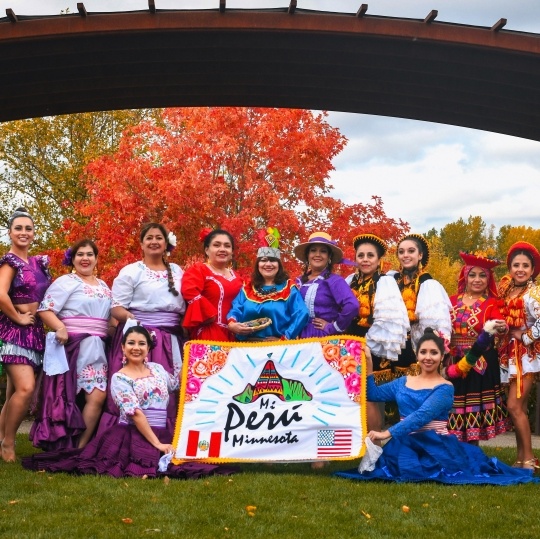
Mi Perú-Minnesota banner
Mi Perú-Minnesota members model a diverse range of traditional Peruvian dance attires while holding a banner with the group's logo. The banner was made in Huancayo, Peru, and intended to be used for the Modern Huaylarsh group dance. Photo by Sarah Leon Waddell, 2022. Used with the permission of Sarah Leon Waddell Photography.
All rights reserved
Articles
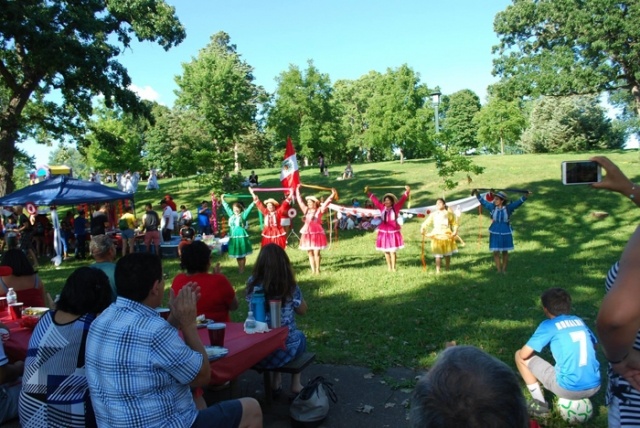
Colorful celebration
Peruvian Independence Day Potluck at Minnehaha Falls Park in Minneapolis, 2017. Mi Perú-Minnesota performs Carnaval Arequipeño, a youthful and joyful dance usually performed at festivals and parades in Arequipa, Peru. Photo used with the permission of Mi Perú-Minnesota.
All rights reserved
Holding Location
Articles
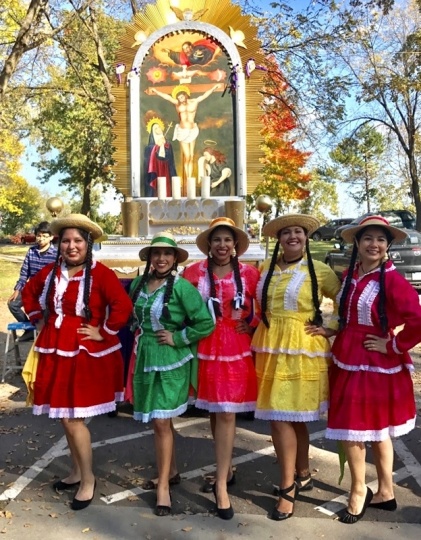
Señor de los Milagros
Mi Perú-Minnesota performs at St. Nicholas Catholic Church in Carver during a celebration of Señor de los Milagros, “The Lord of Miracles,” a Catholic tradition of Peru, ca. 2018 or 2019. Photo used with the permission of Mi Perú-Minnesota.
All rights reserved
Holding Location
Articles
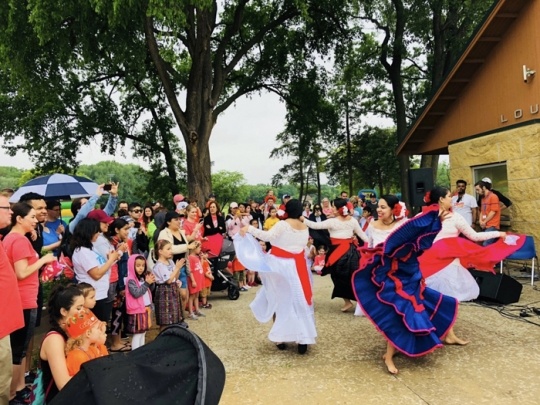
Dancing for a good cause
Marinera dance performance by Mi Perú-Minnesota at Casa de Corazón’s fundraiser event at Louisiana Oaks in St. Louis Park, ca. 2018 or 2019. Photo used with the permission of Mi Perú-Minnesota.
All rights reserved
Holding Location
Articles
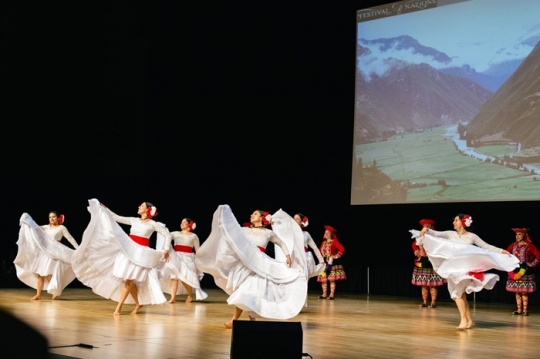
A grand show
Mi Perú-Minnesota performs a marinera and valicha dance at the International Institute of Minnesota’s 2018 Festival of Nations. Photograph by Erika Busse. Used with the permission of Mi Perú-Minnesota.
All rights reserved
Holding Location
Articles
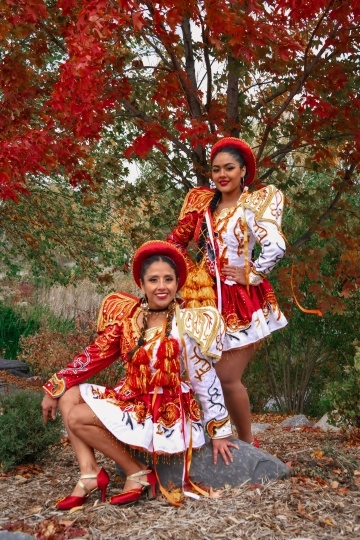
Caporales dance attire
Dancers of Mi Perú-Minnesota wear Caporales dance attire. Caporales is an Afro-Andean dance from the mountain regions of Peru and Bolivia. Photo by Sarah Leon Waddell, 2022. Used with the permission of Sarah Leon Waddell Photography.
All rights reserved
Articles
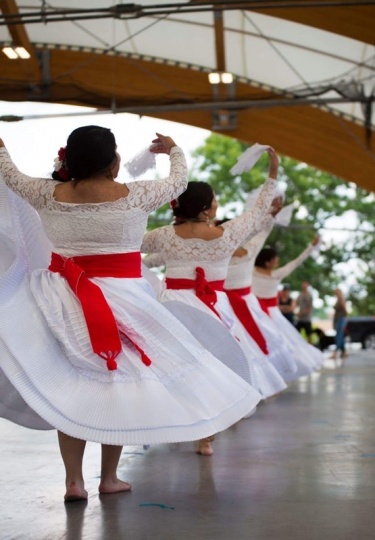
Marinera de corazón
Dancing from the heart to a marinera song, Peru’s national dance, at Mi Perú-Minnesota’s Peruvian Independence Day Celebration event, held at the Recreation Outdoor Center (ROC) in St. Louis Park. Photograph by Angie Garcia, ca. 2018 or 2019. Used with the permission of Alateo Photography.
All rights reserved
Holding Location
Articles
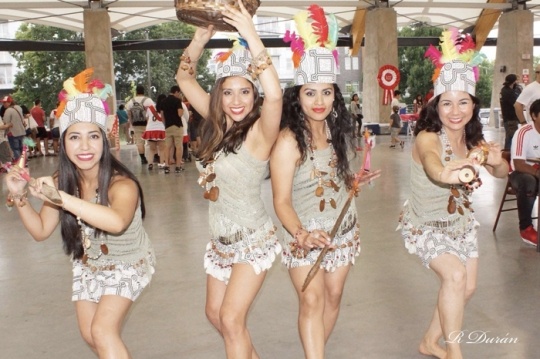
Yacumama dance
Members of Mi Perú-Minnesota representing the Shipibo tribe of Peru through Tahuampa, a style of dance from the rainforest area of Peru. The dance is related to Yacumama, a legendary water serpent of the Peruvian Amazon. Photograph by R. Durán, ca. 2018 or 2019. Used with the permission of Mi Perú-Minnesota.
All rights reserved
Holding Location
Articles
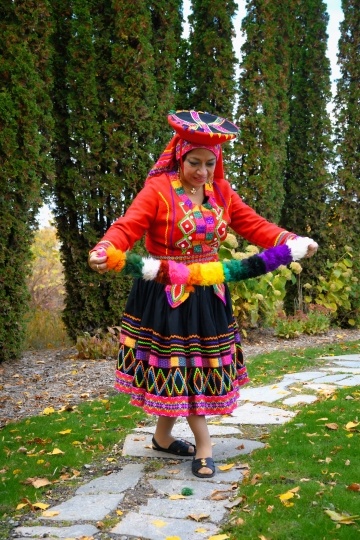
Valicha dance attire from Cusco, Peru
Carmen Alonzo Kohman shows the joy of dancing valicha, a dance from the city of Cusco, Peru. Photo by Sarah Leon Waddell, 2022. Used with the permission of Sarah Leon Waddell Photography.
All rights reserved
Articles
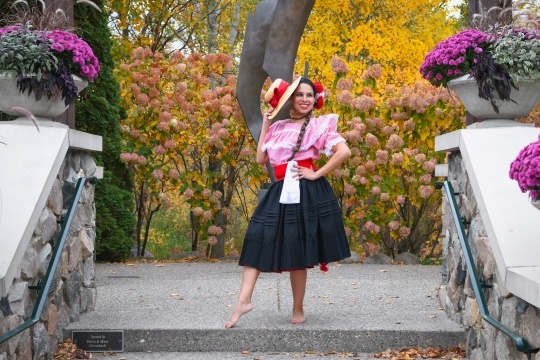
Coastal Tondero dance attire
Tondero, an expressive dance that resembles a bird love ritual, features movements that follow the rhythms of the cajón box drum. Photo by Sarah Leon Waddell, 2022. Used with the permission of Sarah Leon Waddell Photography.
All rights reserved
Articles
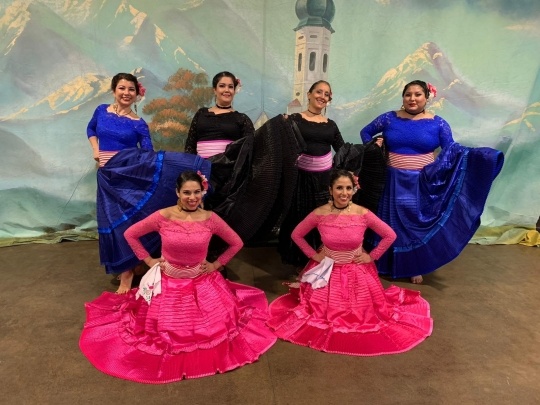
After the show
Marinera dancers after their presentation at the International Institute of Minnesota’s Festival of Nations 2019, held at Roy Wilkins Auditorium in St. Paul. Photo used with the permission of Mi Perú-Minnesota.
All rights reserved
Holding Location
Articles
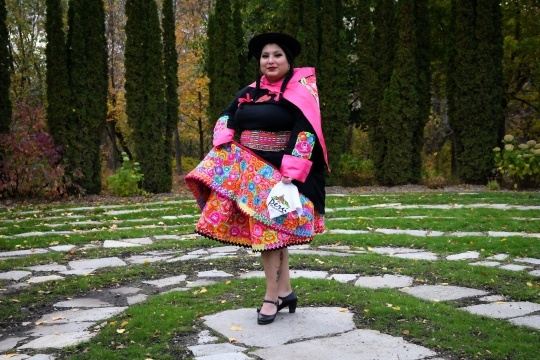
Huaylarsh dance attire from Huancayo, Peru
Huaylarsh dance attire with intricate designs of embroidered flowers and birds. This festive harvesting dance is a patrimony of the Andes region of Peru. Photo by Sarah Leon Waddell, 2022. Used with the permission of Sarah Leon Waddell Photography.
All rights reserved
Articles
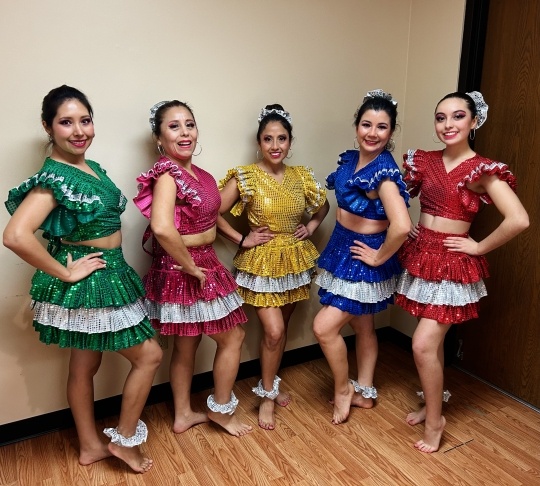
Afro-Peruvian festejo dance attire
Colorful outfits with long skirts enhance the energetic and joyful movements of festejo, an Afro-Peruvian dance from the southern coast of Peru. Photo (ca. 2023) used with the permission of Mi Perú-Minnesota.
All rights reserved
Holding Location
Articles

Community
Mi Perú-MN dances for the Minnesota community at their Peruvian Independence Day Celebration event, held at the Recreation Outdoor Center in St. Louis Park, ca. 2018 or 2019. Used with the permission of Mi Perú-Minnesota.
All rights reserved
Holding Location
Articles
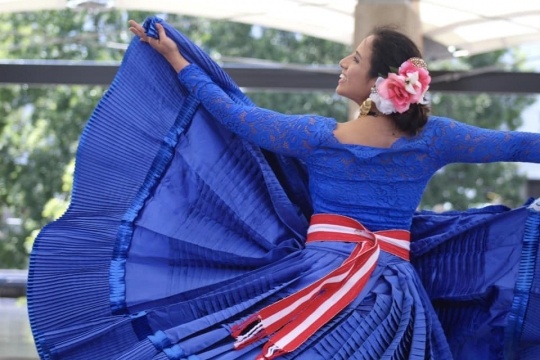
Lucia Carlson
Lucia Carlson shows off attire for a marinera dance: a pleated skirt, gold earrings and a hair brooch, a Peruvian flag-colored belt, and a flower hair piece. Ca. 2018 or 2019. Photograph by Kaia Myers. Used with the permission of Mi Perú-Minnesota.
All rights reserved
Holding Location
Articles
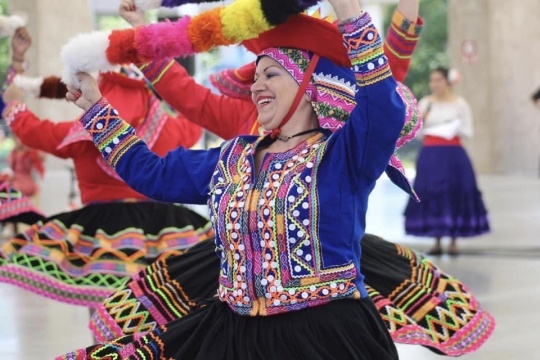
Rosario Parodi Bretey
Rosario Parodi Bretey shows the joy of dancing valicha, a dance from the city of Cusco, Peru. Photograph by Kaia Myers, ca. 2018 or 2019. Used with the permission of Mi Perú-Minnesota.
All rights reserved
Holding Location
Articles

Marinera dance at International Day celebration
The elegant essence of the marinera dance is portrayed here by members of Mi Perú-Minnesota during the annual International Day performance at the International School of Minnesota in Eden Prairie. Photo by Stan Waldhauser, 2024. Used with the permission of Stan Waldhauser.
All rights reserved
Articles
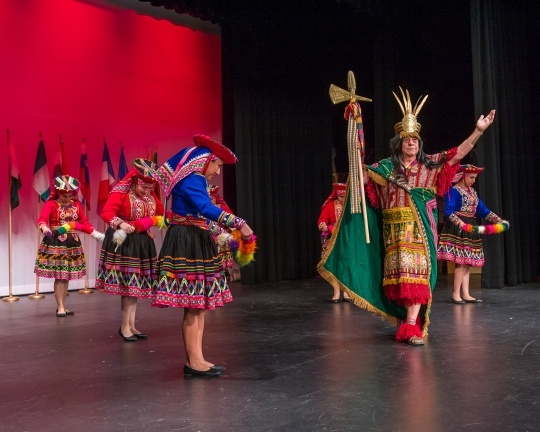
Dancing for the Inca emperor
Valicha dancers show reverence to the Inca emperor as he enters onto the stage. From a performance by Mi Perú-Minnesota at the International School of Minnesota's annual International Day, held in Eden Prairie. Photo by Stan Waldhauser, 2024. Used with the permission of Stan Waldhauser.
All rights reserved
Articles
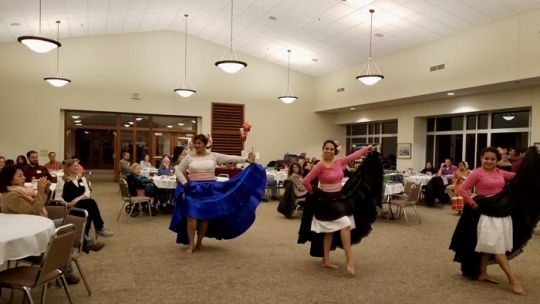
Annual Peruvian fundraising event
Mi Perú-MN performs at the annual Peruvian fundraising event held at St. Peter’s Catholic Church in Mendota Heights, whose donations support a church in Chimbote, Peru. Ca. 2018 or 2019. Photo used with the permission of Mi Perú-Minnesota.
All rights reserved
Holding Location
Articles
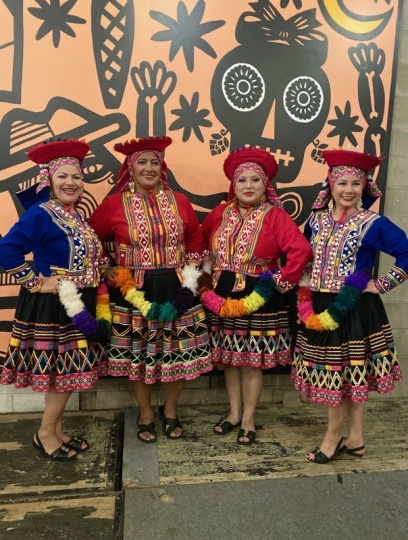
Non-profits supporting non-profits
Mi Perú-MN supports a non-profit organization at a local fundraiser event at La Doña Cervecería in Minneapolis, 2018 or 2019. Photo used with the permission of Mi Perú-Minnesota.
All rights reserved
Holding Location
Articles
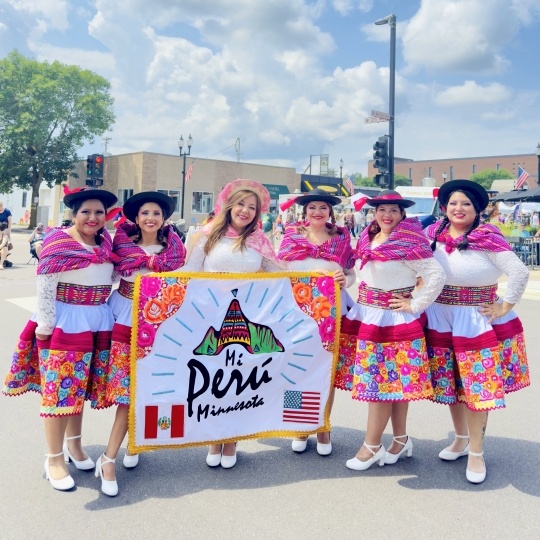
Santiago dance from Huancayo, Peru
Dancers of Mi Perú-Minnesota wear Santiago dance attire from Huaycayo, Peru, ca. 2024. The Santiago dance is a way the Andean community of Huancayo, Peru, pays tribute to the land and gives thanks for the harvests. It is an event full of joy. Photo used with the permission of Mi Perú-Minnesota.
All rights reserved
Holding Location
Articles
Related Articles
Turning Point
On Wednesday, July 26, 2017, some members of Asi Es Mi Perú, as well as prospective members, meet at the Minneapolis Central Library to revise their mission and establish the group Mi Perú-Minnesota. They choose this name to highlight their roots as Peruvians in conversation with three themes: their new home, what it means to be a Peruvian in Minnesota, and what the group can bring to the Minnesota community
Chronology
2017
2017
2017
2018
2018
2019
2019
2019
2023
2024
2024
Bibliography
Busse, Erika. 2020. "¡A Bailarle al Perú! La Tradición al Servicio de la Transgresión." Revista con La A nro. 71 (Septiembre 2020).
https://conlaa.com/a-bailarle-al-peru-la-tradicion-al-servicio-de-la-transgresion
Kolnick, Jeff. “Minnesotanos: Latino Journeys Minnesota.” MNopedia, March 7, 2016.
https://www.mnopedia.org/minnesotanos-latino-journeys-minnesota
Mi Perú-Minnesota [Facebook].
Mi Perú-Minnesota [Instagram].
https://www.instagram.com/miperumn
Mi Perú-Minnesota [official website].
https://miperu-mn.org
www.facebook.com/miperumn
Mi Perú-Minnesota [YouTube].
https://www.youtube.com/channel/UCJjjYKlyOrzvAmnjnWNSrwg
Mi Perú-Minnesota member interviews, March 2020
Oral history interviews conducted by Erika Busse
Description: Mi Perú-Minnesota members share reasons for joining the group and their roles and involvement in it.
United States Census Bureau: QuickFacts Minnesota.
https://www.census.gov/quickfacts/fact/table/MN/RHI725218#RHI725218
Related Resources
Secondary
Wilcox, Hui. “Movement in Space and Liminality: Chinese Dance and Immigrant Identities.” Racial and Ethnic Studies Journal 34, no. 2 (2011): 314–332.
Wilcox, Hui, and Erika Busse. “‘Authentic’ Dance and Racialized Ethnic Identities in Multicultural America: The Chinese in Minnesota and Peruvians in New Jersey.” Sociology of Race and Ethnicity, 2016.






















